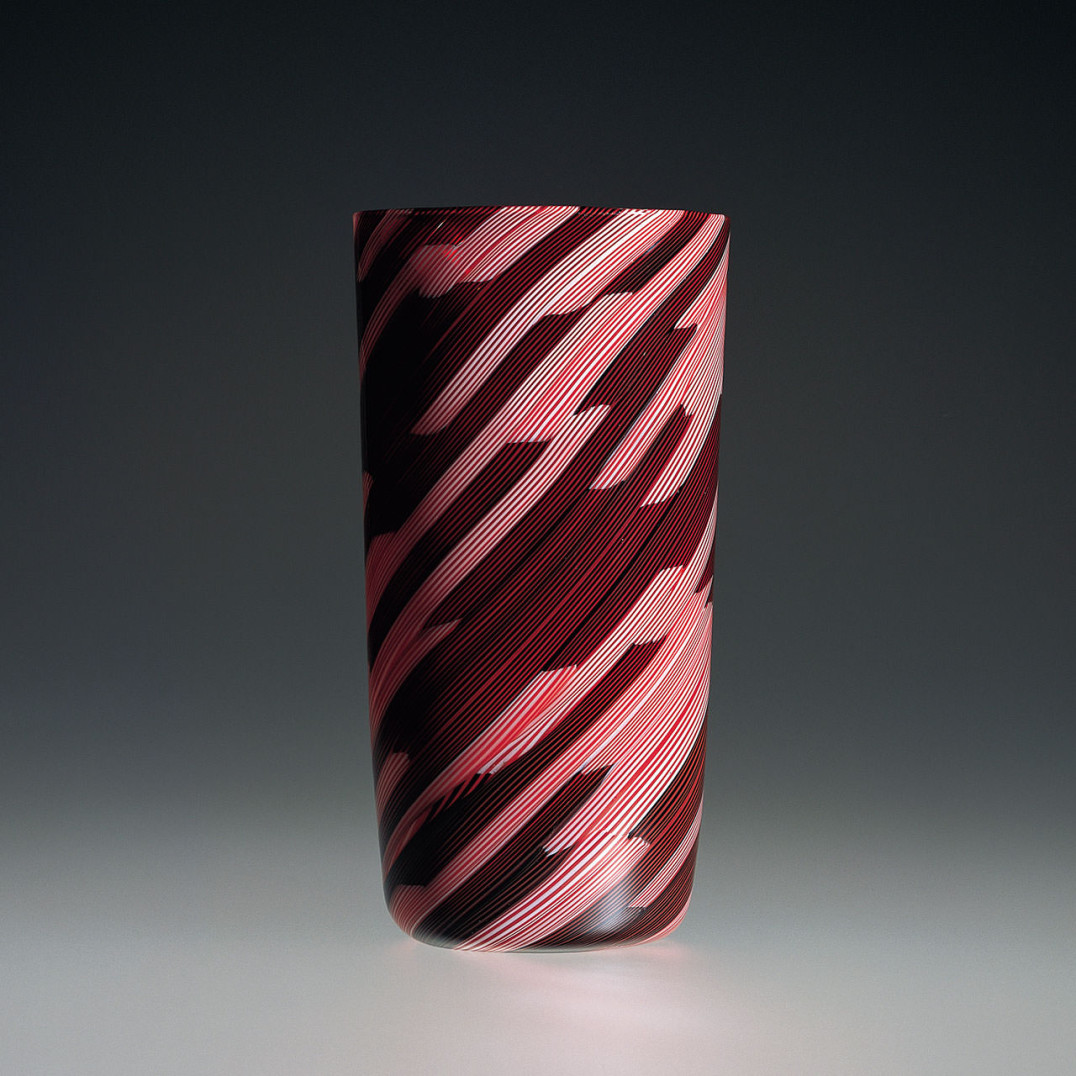
James CarpenterVetro tessuto, ca. 1979
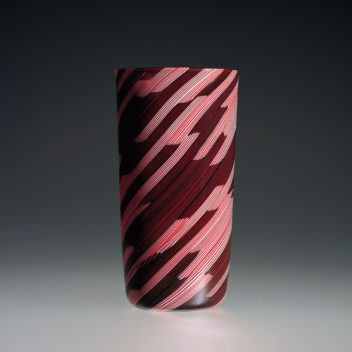
James CarpenterVetro tessutoVenini & C., ca. 1979
A cylindrical tessuto vase, crafted with diagonal fasce of glass that are made of lattimo and coral canes alternating with black and red
coral canes.
Engraved: Carpenter Venini.
10 7/8 in. high (27.6 cm)
Exhibitions:
2000, New York, Venetian Glass, Museum of Arts & Design;
2001, Milan, Murano: Vetri dalla Collezione Olnick Spanu, Spazio Oberdan.
Bibliography and comparative texts:
Olnick Spanu, 2000, n. 147;
Olnick Spanu, 2001, n. 185.
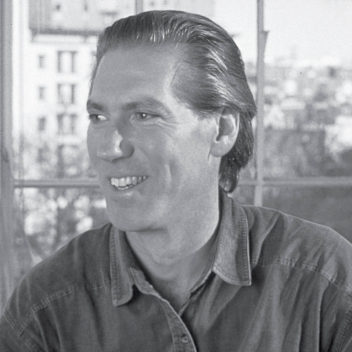
James Carpenter 1949–
Born in Washington, DC, James Carpenter graduated in 1972 from the Rhode Island School of Design with a B.F.A. in Sculpture. After his first collaboration at Venini, from October 1971 to May 1972, Carpenter returned several times to participate in the design of various glassworks. During this time, he worked along with Ludovico Diaz de Santillana, experimenting in new techniques for the creation of large multicolored glass windows. His designs were included in the exhibition of historical and contemporary Venini glass held in New York in 1984. Among the works he designed for Venini is the Calabash, executed with the use of multicolored glass rods. For more than twenty-five years, Carpenter's work has focused on the exploration of light as a means to bring form to structure and reveal the environment. As an artist considered to be a foremost innovator in materials technologies, Carpenter has worked collaboratively with major architects in the United States and abroad on significant building projects and has received many major architectural and public art commissions. Carpenter currently works in New York.

Venini & C. 1932–2001
In 1932, when both Martinuzzi and Zecchin left the company, Paolo Venini changed the name from Vetri Soffiati Muranesi Venini & Co. (V.S.M. Venini & Co.) to Venini & C.. Milanese architect Tommaso Buzzi became the new artistic director. After 1934, artistic direction was taken on by Carlo Scarpa, who designed most of the company's production through 1947. Side by side with Venini, who often intervened personally in design, Scarpa created numerous collections of objects characterized by refined colors. After World War II, Venini & C. sought numerous collaborations with artists such as architect Giò Ponti and the Swedish-born Tyra Lundgren. After 1948, Fulvio Bianconi, Massimo Vignelli, and Tobia Scarpa contributed significantly to the new direction of the company. Paolo Venini died in 1959 and his son-in-law, Ludovico Diaz de Santillana, took over the management of Venini & C. He not only worked personally as a glass designer but also continued the collaboration started by Paolo Venini with various artists and designers. Starting in 1960, many other designers collaborated with the company, like Thomas Stearns, Toni Zuccheri, Tapio Wirkkala, Laura and Alessandro Diaz de Santillana, James Carpenter, Dan Dailey, Richard Marquis, Benjamin Moore, and Toots Zynsky. In 1986, the de Santillana family left the company, selling their stock to the Ferruzzi group, which guaranteed the fine quality Venini was known for by hiring new designers such as Timo Sarpaneva, Marco Zanini, Ettore Sottsass Jr., Alessandro Mendini, Mario Bellini, Barbara del Vicario, and others. In 1988, Venini was acquired by Royal Scandinavian. Since 2001, Venini S.p.A. has been part of Italian Luxury Industries Group and is led by Giancarlo Chimento, Giuliano Tabacchi, and Giorgio Rizzo.
James CarpenterVetro tessuto, ca. 1979
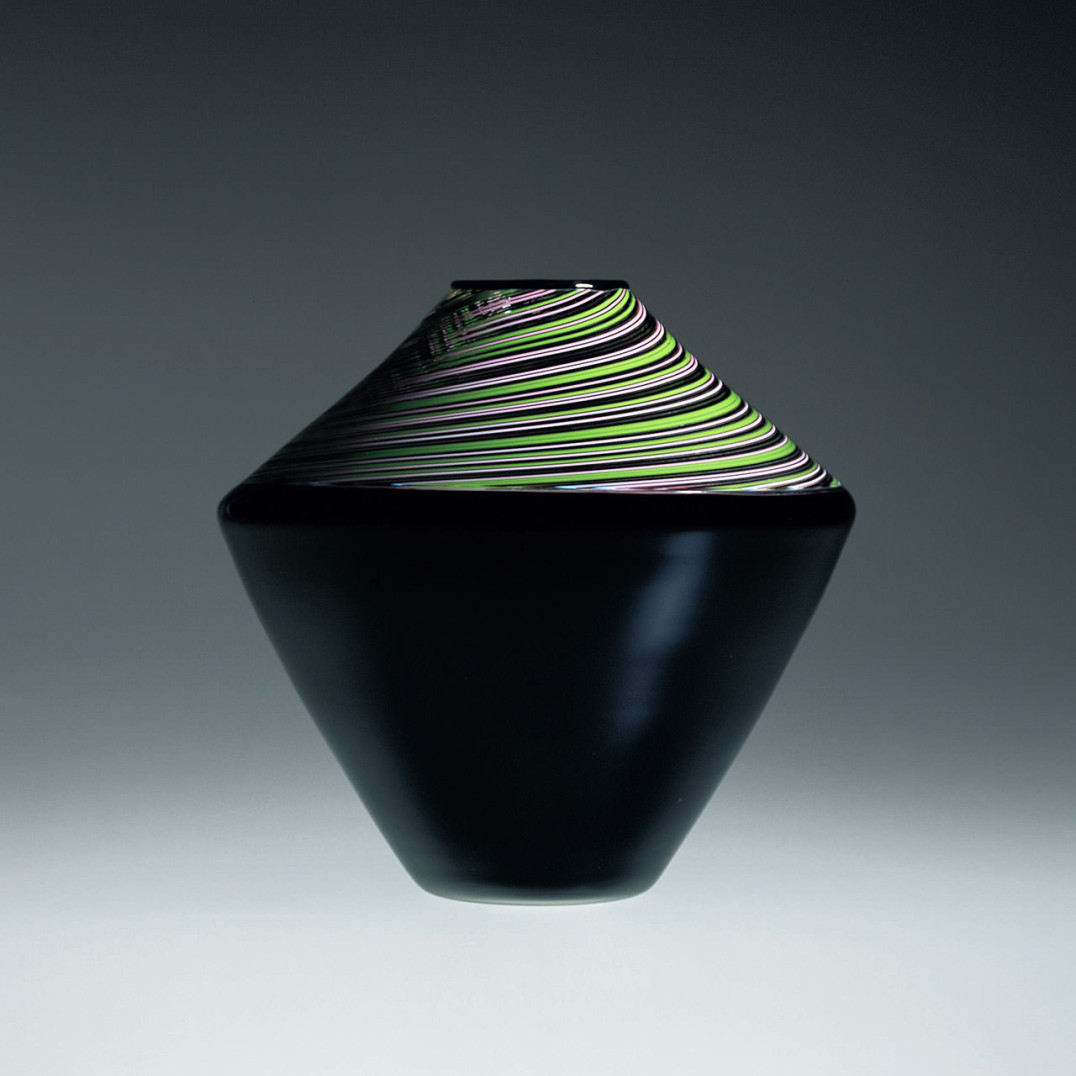
Benjamin MooreTessuto ad incalmo, 1979
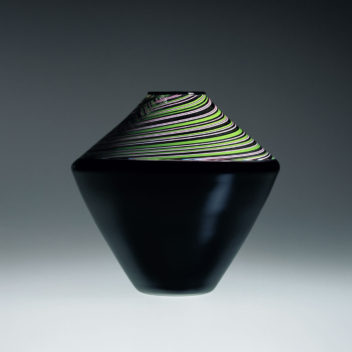
Benjamin MooreTessuto ad incalmoVenini & C., 1979
Vase in tessuto glass. The upper portion is composed of a spiraling pink, green, and black canes of glass, the lower portion is made of black glass. The two portions are bonded with the incalmo technique.
Engraved: Benjamin Moore Venini.
10 7/16 in. high (26.5 cm)
Exhibitions:
2000, New York, Venetian Glass, Museum of Arts & Design;
2001, Milan, Murano: Vetri dalla Collezione Olnick Spanu, Spazio Oberdan.
Bibliography and comparative texts:
A. Venini Diaz de Santillana, 1989, n. 249;
M. Barovier, 1999, p. 289;
Olnick Spanu, 2000, n. 146;
Olnick Spanu, 2001, n. 184;
A. Dorigato, 2002, p. 349.
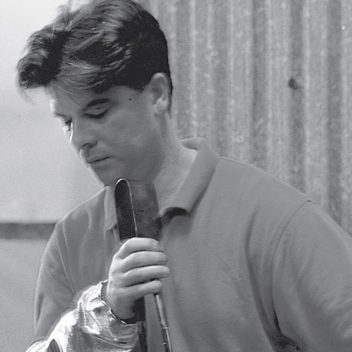
Benjamin Moore 1952–
Benjamin Moore was born in Olympia, Washington. From 1970 to 1972, he attended Central Washington University in Ellensburg, Washington. He spent 1972 at the Instituto de Artes Plasticas in Guadalajara, Mexico, and in 1974, he obtained a B.F.A. with a major in Ceramics from the California College of the Arts in Oakland. In 1977, he received an M.F.A. with a major in Glass-Sculpture from the prestigious Rhode Island School of Design and began working as a designer for the Fostoria Glass Company in Moundsville, West Virginia. From 1978 to May of 1980, he worked at Venini in Murano, where his first assignment was to help the team of maestro Checco Ongaro by performing various tasks. In the spring of 1979, Ongaro offered to execute some of Moore’s designs. The result so impressed Ludovico Diaz de Santillana that Moore was asked to continue the collaboration with Venini as a designer until 1980. After several teaching positions that took him from the Niijima Glass Art Center in Japan to the Haystack Mountain School of Design to the Rhode Island School of Design, he presently serves as a Board Member at the Pilchuck Glass School in Stanwood, Washington. In addition, Mr. Moore owns and operates the Artist’s Glass Studio Benjamin Moore, Inc. in Seattle, Washington.

Venini & C. 1932–2001
In 1932, when both Martinuzzi and Zecchin left the company, Paolo Venini changed the name from Vetri Soffiati Muranesi Venini & Co. (V.S.M. Venini & Co.) to Venini & C.. Milanese architect Tommaso Buzzi became the new artistic director. After 1934, artistic direction was taken on by Carlo Scarpa, who designed most of the company's production through 1947. Side by side with Venini, who often intervened personally in design, Scarpa created numerous collections of objects characterized by refined colors. After World War II, Venini & C. sought numerous collaborations with artists such as architect Giò Ponti and the Swedish-born Tyra Lundgren. After 1948, Fulvio Bianconi, Massimo Vignelli, and Tobia Scarpa contributed significantly to the new direction of the company. Paolo Venini died in 1959 and his son-in-law, Ludovico Diaz de Santillana, took over the management of Venini & C. He not only worked personally as a glass designer but also continued the collaboration started by Paolo Venini with various artists and designers. Starting in 1960, many other designers collaborated with the company, like Thomas Stearns, Toni Zuccheri, Tapio Wirkkala, Laura and Alessandro Diaz de Santillana, James Carpenter, Dan Dailey, Richard Marquis, Benjamin Moore, and Toots Zynsky. In 1986, the de Santillana family left the company, selling their stock to the Ferruzzi group, which guaranteed the fine quality Venini was known for by hiring new designers such as Timo Sarpaneva, Marco Zanini, Ettore Sottsass Jr., Alessandro Mendini, Mario Bellini, Barbara del Vicario, and others. In 1988, Venini was acquired by Royal Scandinavian. Since 2001, Venini S.p.A. has been part of Italian Luxury Industries Group and is led by Giancarlo Chimento, Giuliano Tabacchi, and Giorgio Rizzo.
Benjamin MooreTessuto ad incalmo, 1979
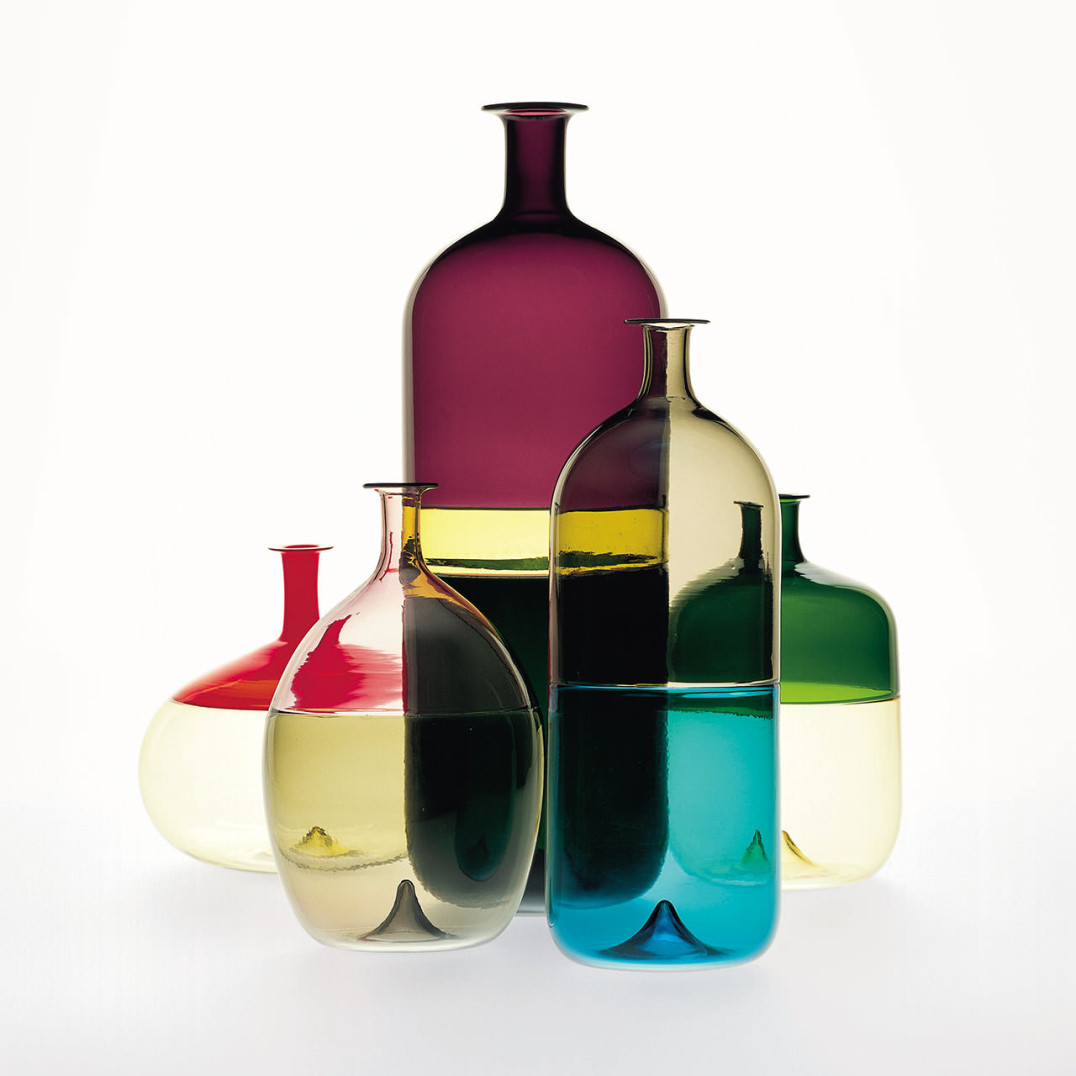
Tapio WirkkalaBolle, 1966
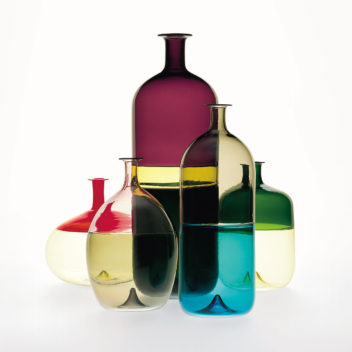
Tapio WirkkalaBolleVenini & C., 1966
A group of five multicolored decanter-shaped vases. Blown with very thin, pale colored transparent glass, all works are obtained with the use of the incalmo technique.
Engraved:
venini ITALIA TW.
7 1/4 in. to 17 in. high
(18.4 to 43.2 cm)
Exhibitions:
2000, New York, Venetian Glass, Museum of Arts & Design;
2001, Milan, Murano: Vetri dalla Collezione Olnick Spanu, Spazio Oberdan.
Bibliography and comparative texts:
Domus, 1968, February;
G. Mazzotti, T. Carta, 1971, p. 155;
Venezianisches…, 1981, n. 40;
Murano Oggi, 1981, nn. 512-516;
R. Barovier Mentasti, 1992, n. 322;
Mille anni…, 1982, n. 653;
G. Duplani Tucci, 1989, nn. 46-49;
M. Heiremans, 1989, n. 221;
A. Venini Diaz de Santillana, 1996, n. 238;
Venini Venezia, 1998, p. 77;
M. Barovier, 1999, p. 271;
A. Venini Diaz de Santillana, 2000, n. 242;
Olnick Spanu, 2000,
n. 145;
Olnick Spanu, 2001, n. 183.
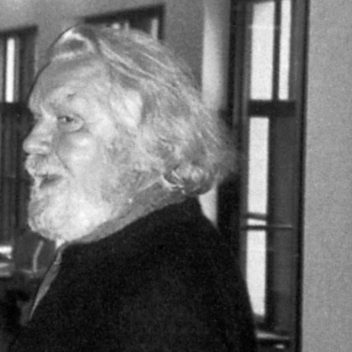
Tapio Wirkkala 1915–1985
Born in Finland, from 1933 to 1936 Tapio Wirkkala attended the Central School for the Industrial Arts in Helsinki, where later he became artistic director. In 1946, he became part of the design team of the Finnish workshop Karhula Ittala, for which he produced his most famous designs and with which he remained associated until his death. Well known in Italy as well, his crystal works were shaped and cut in forms inspired by Nordic nature. A fervent scholar of materials, Wirkkala created objects not only in glass, but also in metal, wood, ceramic, and silver. He came to Venini for the first time in 1966 and continued his collaboration through 1972, only to return again in 1985. Wirkkala mastered Venetian techniques such as incalmo, filigrana, and murrina with great sensitivity. The result was a series of collections of greatly refined glass pieces with extraordinary colors, which wed the purity of Nordic design to the transparency of Murano glass in an incomparable style.

Venini & C. 1932–2001
In 1932, when both Martinuzzi and Zecchin left the company, Paolo Venini changed the name from Vetri Soffiati Muranesi Venini & Co. (V.S.M. Venini & Co.) to Venini & C.. Milanese architect Tommaso Buzzi became the new artistic director. After 1934, artistic direction was taken on by Carlo Scarpa, who designed most of the company's production through 1947. Side by side with Venini, who often intervened personally in design, Scarpa created numerous collections of objects characterized by refined colors. After World War II, Venini & C. sought numerous collaborations with artists such as architect Giò Ponti and the Swedish-born Tyra Lundgren. After 1948, Fulvio Bianconi, Massimo Vignelli, and Tobia Scarpa contributed significantly to the new direction of the company. Paolo Venini died in 1959 and his son-in-law, Ludovico Diaz de Santillana, took over the management of Venini & C. He not only worked personally as a glass designer but also continued the collaboration started by Paolo Venini with various artists and designers. Starting in 1960, many other designers collaborated with the company, like Thomas Stearns, Toni Zuccheri, Tapio Wirkkala, Laura and Alessandro Diaz de Santillana, James Carpenter, Dan Dailey, Richard Marquis, Benjamin Moore, and Toots Zynsky. In 1986, the de Santillana family left the company, selling their stock to the Ferruzzi group, which guaranteed the fine quality Venini was known for by hiring new designers such as Timo Sarpaneva, Marco Zanini, Ettore Sottsass Jr., Alessandro Mendini, Mario Bellini, Barbara del Vicario, and others. In 1988, Venini was acquired by Royal Scandinavian. Since 2001, Venini S.p.A. has been part of Italian Luxury Industries Group and is led by Giancarlo Chimento, Giuliano Tabacchi, and Giorgio Rizzo.
Tapio WirkkalaBolle, 1966
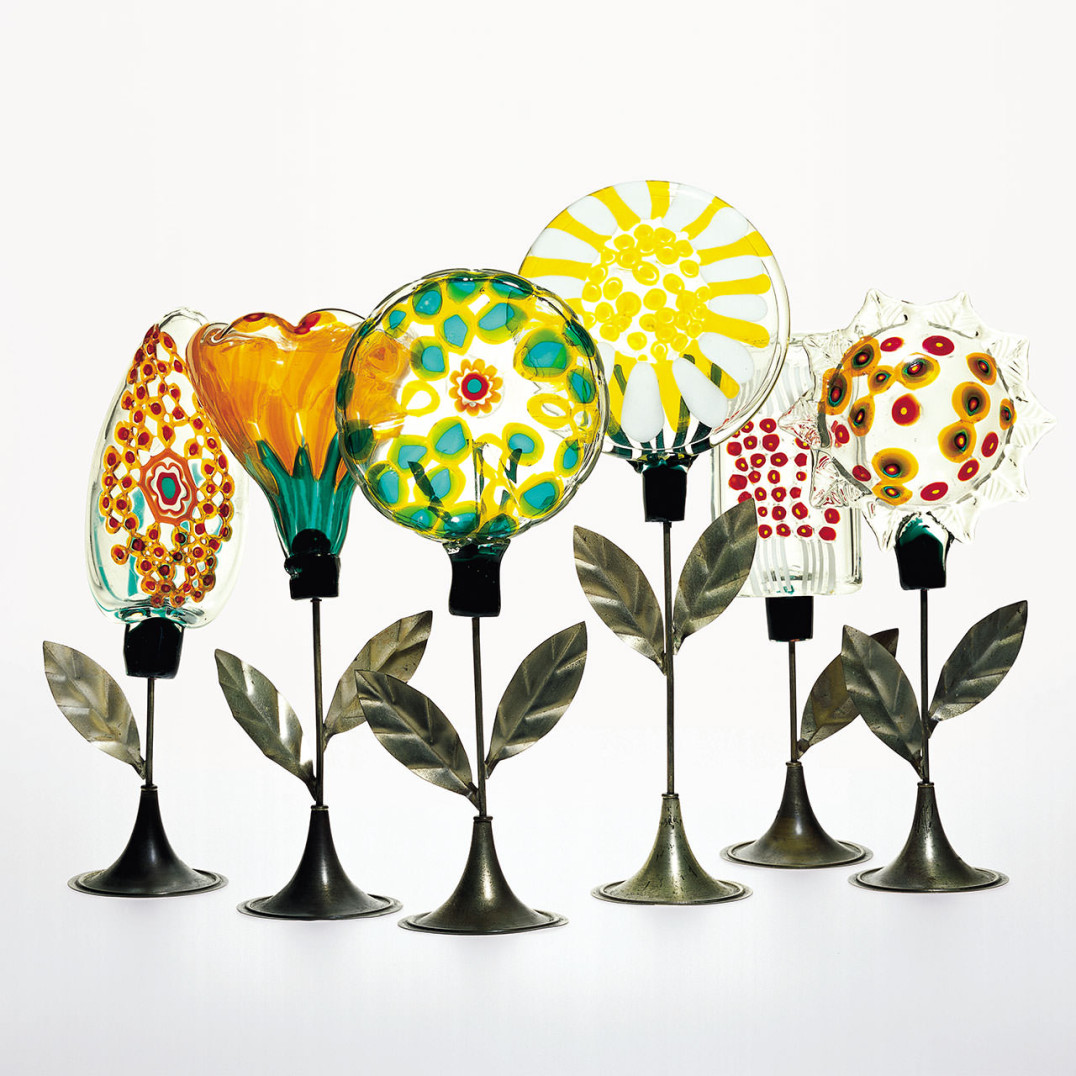
Anzolo FugaFiori, ca. 1968
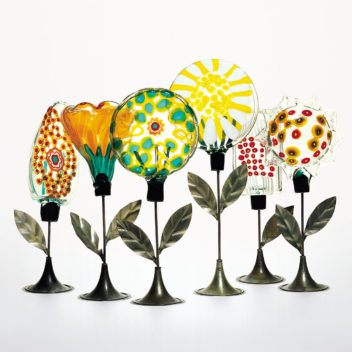
Anzolo FugaFioriAureliano Toso Vetri Decorativi, ca. 1968
A group of six flowers made in transparent glass. All decorated with murrine and multicolored glass canes. Each flower sits on a metal base that emulates leaves and stems.These flowers are prototypes and were never produced.
14 5/16 in. to 18 3/4 in. high
(36.4 to 47.6 cm)
Exhibitions:
2000, New York, Venetian Glass, Museum of Arts & Design;
2001, Milan, Murano: Vetri dalla Collezione Olnick Spanu, Spazio Oberdan.
Bibliography and comparative texts:
Howard J. Lockwood, 2000, cover;
Olnick Spanu, 2000, n. 144;
Olnick Spanu, 2001, n. 182.
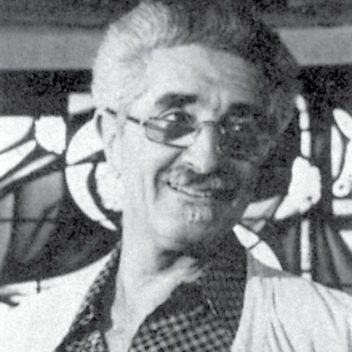
Anzolo Fuga 1915–1998
Anzolo Fuga was born on Murano. He apprenticed as a draftsman at the Cristalleria di Venezia e Murano and attended the Istituto d'Arte di Venezia, where he studied under Guido Balsamo Stella. In 1954, he opened a shop for the decoration of blown glass and the art of stained-glass windows, and it was there that he began to use sheets of Murano glass blown and decorated in hot-work: his colorful stained glass windows were successfully exhibited in several editions of the Biennale. He was director of the Abate Zanetti School of Art for Glassworkers from 1949 through 1972, and he collaborated freelance with several workshops after the late '50s. Among them was A.VE.M., for whom he created large pieces with asymmetric shapes and abstract decor, using murrine and glass rods in almost all of his brightly colored collections. During this time, he also collaborated with Domus Vetri d'Arte and IVR Mazzega.
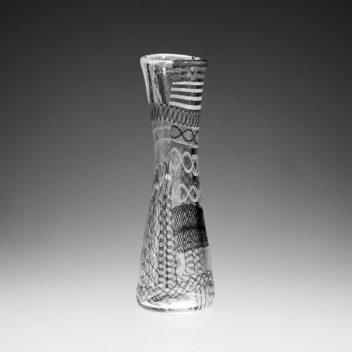
Aureliano Toso Vetri Decorativi 1932–
Founded in 1938 by Aureliano Toso, Aureliano Toso Vetri Decorativi boasted the artistic direction of Dino Martens, a painter from Murano, who worked with the company until 1965. The works created by Martens brought widespread acclaim at the major exhibitions of decorative arts, the colors being of particular interest. In 1962, the company sought the collaboration of outside consultants like Enrico Potz. After 1966, the artistic direction was entrusted to Gino Poli, who designed, among others, the collection A Solchi Colorati. Later, the company turned to the production of glass parts for lighting, which it still produces today.
Anzolo FugaFiori, ca. 1968
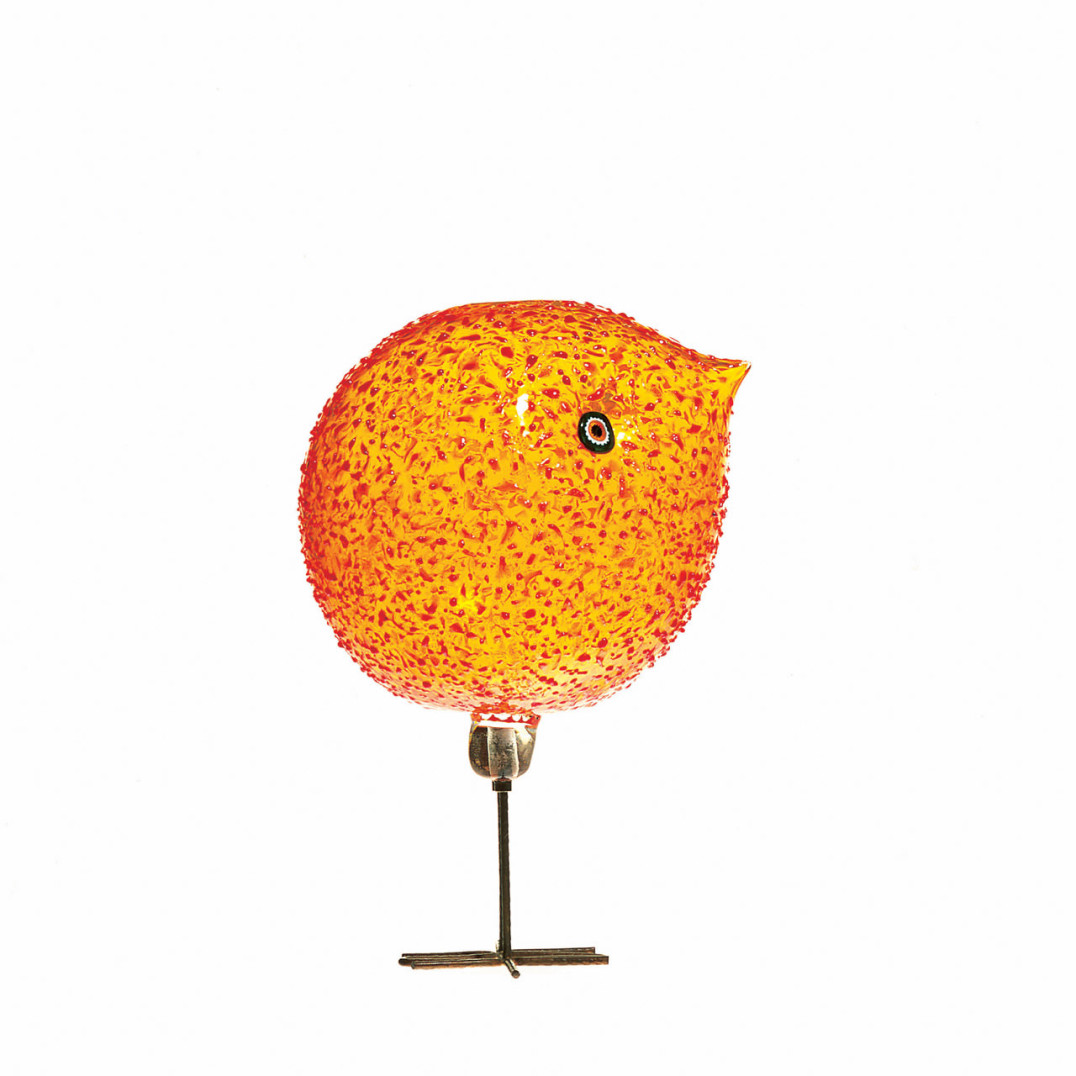
Alessandro PianonPulcino, 1960-1961
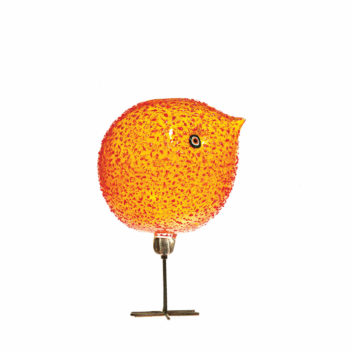
Alessandro PianonPulcinoVetreria Vistosi, 1960-1961
Pulcino made of orange trasparente glass, decorated with granzeoli made of glass grit. Feet crafted
in copper.
8 1/4 in. high (22.2 cm)
Exhibitions:
2000, New York, Venetian Glass, Museum of Arts & Design;
2001, Milan, Murano: Vetri dalla Collezione Olnick Spanu, Spazio Oberdan.
Bibliography and comparative texts:
Domus, 1962, April;
B. Nerozzi, 1987, nn. 130-133;
M. Heiremans, 1989, nn. 230, 231;
M. Karasik, 1989, n. 36;
R. Barovier Mentasti, 1992, n. 119;
M. Heiremans, 1993, n. 249;
F. Deboni, 1996, n. 243;
M. Heiremans, 1996, nn. 209, 211, 212;
M. Barovier, 1996, n. 103;
M. Barovier, 1999, p. 275;
Olnick Spanu, 2000, n. 143;
Olnick Spanu, 2001, n. 180.
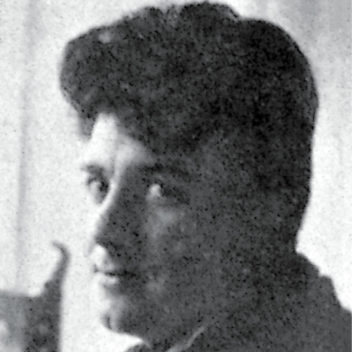
Alessandro Pianon 1931–1984
Born in Venice, Alessandro Pianon attended the Architecture School in Venice and used his talents to become an architect and designer. He was hired by the Vetreria Vistosi in 1956 to design the company logo and ended up designing numerous collections of glass. In 1962 he started his own design studio and worked for many companies, including Lumenform.
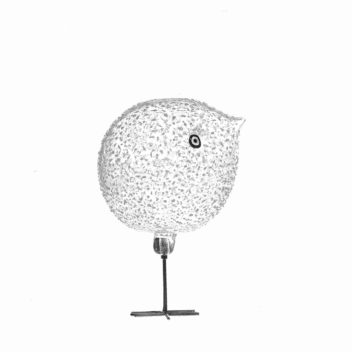
Vetreria Vistosi 1945–1990
The descendant of a family who had been Murano glassmakers for hundreds of years, Guglielmo Vistosi opened the Vistosi furnace in 1945 to produce glass components for lighting. After his death in 1952, the direction of the company was taken over by his brother Oreste and his nephews Gino and Luciano. They carried on the line of production, serving as designers as well. Vistosi also sought the collaboration of many independent artists and professionals such as Alessandro Pianon, Peter Pelzel, and Fulvio Bianconi. During the '60s, the company, successful for its essential forms and the sobriety of its colors, received many awards. During the following decade, its pieces were designed by Angelo Mangiarotti, Enrico Capuzzo, Gae Aulenti, Vico Magistretti, Elenore Peduzzi Riva, and Ettore Sottsass Jr. After the company's change of ownership, the furnace produced glass components for lighting until it was closed in the early '90s.